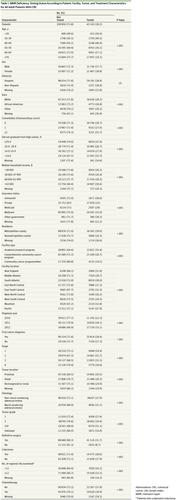JAMA Oncology ( IF 22.5 ) Pub Date : 2018-02-01 , DOI: 10.1001/jamaoncol.2017.3580 Talha Shaikh 1 , Elizabeth A Handorf 2 , Joshua E Meyer 1 , Michael J Hall 3 , Nestor F Esnaola 4

|
Importance Mismatch repair (MMR) deficiency of DNA has been observed in up to 15% of sporadic colorectal cancers (CRCs) and is a characteristic feature of Lynch syndrome, which has a higher incidence in young adults (age, <50 years) with CRC. Mismatch repair deficiency can be due to germline mutations or epigenetic inactivation, affects prognosis and response to systemic therapy, and results in unrepaired repetitive DNA sequences, which increases the risk of multiple malignant tumors.
Objective To evaluate the utilization of MMR deficiency testing in adults with CRC and analyze nonadherence to long-standing testing guidelines in younger adults using a contemporary national data set to help identify potential risk factors for nonadherence to newly implemented universal testing guidelines.
Design, Setting, and Participants Adult (age, <30 to ≥70 years) and, of these, younger adult (<30 to 49 years) patients with invasive colorectal adenocarcinoma diagnosed between 2010 and 2012 and known MMR deficiency testing status were identified using the National Cancer Database. The study was conducted from March 16, 2016, to March 1, 2017.
Exposures Patient sociodemographic, facility, tumor, and treatment characteristics.
Main Outcomes and Measures The primary outcome of interest was receipt of MMR deficiency testing. Multivariable logistic regression was used to identify independent predictors of testing in adult and/or young adult patients.
Results A total of 152 993 adults with CRC were included in the study (78 579 [51.4%] men; mean [SD] age, 66.9 [13.9] years). Of these patients, only 43 143 (28.2%) underwent MMR deficiency testing; the proportion of patients tested increased between 2010 and 2012 (22.3% vs 33.1%; P<.001). Among 17 218 younger adult patients with CRC, only 7422 (43.1%) underwent MMR deficiency testing; the proportion tested increased between 2010 and 2012 (36.1% vs 48.0%; P < .001). Irrespective of age, higher educational level (OR, 1.38; 95% CI, 1.15-1.66), later diagnosis year (OR, 1.81; 95% CI, 1.65-1.98), early stage disease (OR, 1.24; 95% CI, 1.18-1.30), and number of regional lymph nodes examined (≥12) (OR, 1.44; 95% CI, 1.34-1.55) were independently associated with MMR deficiency testing, whereas older age (OR, 0.31; 95% CI, 0.26-0.37); Medicare (OR, 0.89; 95% CI, 0.84-0.95), Medicaid (OR, 0.83; 95% CI, 0.73-0.93), or uninsured (OR, 0.78; 95% CI, 0.66-0.92) status; nonacademic vs academic/research facility type (OR, 0.44; 95% CI, 0.34-0.56); rectosigmoid or rectal tumor location (OR, 0.76; 95% CI, 0.68-0.86); unknown grade (OR, 0.61; 95% CI, 0.53-0.69); and nonreceipt of definitive surgery (OR, 0.33; 95% CI, 0.30-0.37) were associated with underuse of MMR deficiency testing.
Conclusions and Relevance Despite recent endorsement of universal use of MMR deficiency testing in patients with CRC and well-established guidelines aimed at high-risk populations, overall utilization of testing is poor and significant underuse of testing among young adults persists. Interventions tailored to groups at risk for nonadherence to guidelines may be warranted in the current era of universal testing.
中文翻译:

结直肠癌患者的错配修复缺陷检测和不遵守检测指南的年轻人
在高达 15% 的散发性结直肠癌 (CRC) 中观察到 DNA错 配修复 (MMR) 缺陷,这是 Lynch 综合征的一个特征,在患有 CRC 的年轻人(年龄<50 岁)中发病率更高. 错配修复缺陷可能是由于种系突变或表观遗传失活,影响预后和对全身治疗的反应,并导致未修复的重复 DNA 序列,这增加了多种恶性肿瘤的风险。
目的 评估 MMR 缺陷检测在成人 CRC 中的应用,并使用当代国家数据集分析年轻人对长期检测指南的不遵守情况,以帮助确定不遵守新实施的通用检测指南的潜在风险因素。
设计、设置和参与者 成人(年龄,<30 至 ≥ 70 岁)和其中年轻成人(<30 至 49 岁)在 2010 年至 2012 年期间诊断为侵袭性结直肠腺癌且已知 MMR 缺陷检测状态的患者使用以下方法进行鉴定国家癌症数据库。该研究于 2016 年 3 月 16 日至 2017 年 3 月 1 日进行。
暴露 患者的社会人口统计学、设施、肿瘤和治疗特征。
主要结果和测量 感兴趣的主要结果是接受 MMR 缺陷测试。多变量逻辑回归用于确定成人和/或年轻成人患者测试的独立预测因子。
结果 共有 152 993 名成人 CRC 被纳入研究(78 579 [51.4%] 男性;平均 [SD] 年龄,66.9 [13.9] 岁)。在这些患者中,只有 43 143 人 (28.2%) 接受了 MMR 缺陷检测;2010 年至 2012 年间,接受检测的患者比例有所增加(22.3% 对 33.1%;P <.001)。在 17218 名年轻的 CRC 患者中,只有 7422 人(43.1%)接受了 MMR 缺陷检测;2010 年至 2012 年间测试的比例有所增加(36.1% 对 48.0%;P < .001)。不考虑年龄、更高的教育水平(OR,1.38;95% CI,1.15-1.66)、较晚诊断年份(OR,1.81;95% CI,1.65-1.98)、早期疾病(OR,1.24;95% CI, 1.18-1.30) 和检查的区域淋巴结数量 (≥12) (OR, 1.44; 95% CI, 1.34-1.55) 与 MMR 缺陷检测独立相关,而年龄较大 (OR, 0.31; 95% CI, 0.26 -0.37); 医疗保险(OR,0.89;95% CI,0.84-0.95)、医疗补助(OR,0.83;95% CI,0.73-0.93)或无保险(OR,0.78;95% CI,0.66-0.92)状态;非学术与学术/研究设施类型(OR,0.44;95% CI,0.34-0.56);直肠乙状结肠或直肠肿瘤位置(OR,0.76;95% CI,0.68-0.86);未知等级(OR,0.61;95% CI,0.53-0.69);和未接受确定性手术(OR,0.33;95% CI,0.30-0.37)与未充分使用 MMR 缺陷检测有关。
结论和相关性 尽管最近支持在 CRC 患者中普遍使用 MMR 缺陷检测,并针对高危人群制定了完善的指南,但检测的总体利用率很低,并且年轻人中检测的严重不足仍然存在。在当前普遍测试的时代,可能需要针对有不遵守指南风险的群体进行干预。











































 京公网安备 11010802027423号
京公网安备 11010802027423号